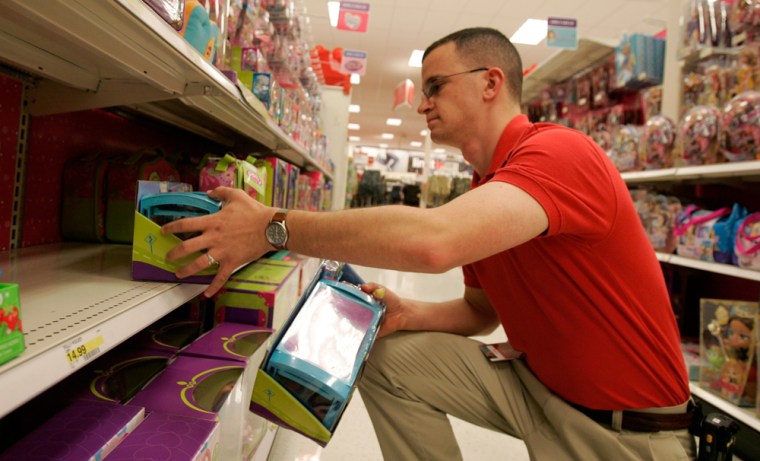At Building Blocks Toy Store in Chicago, owner Katherine McHenry is used to getting lots of questions about toys. But these days, the questions are veering into new territory.
Instead of wondering whether a toy is right for a child’s age or development level, more parents are asking whether the paint on the toy is nontoxic, or which toys in the store are made in the United States.
McHenry said business hasn’t been hurt by the recent recalls of Chinese-made toys that could contain lead paint and other hazards. But, she adds, “I think that people are definitely educating themselves a bit more, being a little more cautious, rather than just walking into a store and buying a product and thinking, ‘OK, this is good stuff.’”
Mattel Inc. on Tuesday recalled around 9 million toys because they could contain dangerous lead paint or have magnets that children could swallow.
The massive recall, just the latest in a series of safety concerns over products made in China, is stoking worries over whether the toys that many have trusted for years could, in fact, contain harmful agents.
“Parents are alarmed by all the major recalls that have been happening. They’re definitely concerned,” said Sarah Chusid, program associate Kids in Danger, a nonprofit group devoted to improving children’s product safety.
Some advocates also argue the spate of bad news should serve as a wake-up call that consumers need to demand better safety oversight.
"It’s more than just the industry stepping up. I think our government agencies have to step up. I think the Chinese agencies have to step up," said Don Mays, senior director of product safety planning for Consumer Reports.
He added the retailers, too, need to have more accountability for ensuring that the toys on their shelves are safe.
Ed Mierzwinski, consumer program director for U.S. Public Interest Research Groups, a longtime advocate of toy safety improvements, said the massive recalls should make clear that even big, well-known companies can have safety lapses.
He is hoping the recent recalls will help prompt parents to press elected officials to step up regulation of the toy industry, and increase funding for the regulatory agency.
“This agency is hamstrung,” he said.
If parents of caregivers suspect that a toy is harmful, Mierzwinski said they should contact the Consumer Product Safety Commission.
He also urges parents to avoid products that look like they have been shoddily made or are at risk for breaking, even if the toy appears to come from a well-known or pricey brand. Mierzwinski also recommends removing any toy from the house that contains small, powerful magnets, as those toys can be extremely hazardous to children if swallowed. Some of the toys Mattel recalled Tuesday contained such magnets.
“Parents should just use common sense,” he said. “They should not presume that any toy meets U.S. standards just because it comes from a brand name company.”
The biggest danger, he said, is in households where there is an older child, between the ages of 4 and 7, using toys that pose a choking or other hazard to a younger sibling under age 3.
Mays recommends getting rid of any toys that have chipping paint or cracked vinyl, and said an added safety precaution would be to not buy any metal jewelry, since it could contain lead.
But some risks aren't as apparent. Chusid, of Kids in Danger, said the recalls involving lead paint are especially worrisome because a parent can’t necessarily tell whether a toy contains the potentially toxic substance.
“What’s so scary to parents and is so hard is that you can’t actually see the danger, particularly with lead,” she said.
She recommends that parents sign up for e-mailed product recall alerts from federal regulators, and stay vigilant about monitoring whether their children’s toys, jewelry or other items show up on a recall list.
Still,, it is impractical for most parents to take drastic action such as avoiding all toys made in China. For one thing, with most toy manufacturers relying at least partly on cheaper overseas production, that would make it all but impossible to shop for children this holiday season.
Mattel, for example, said Tuesday that 65 percent of the toys it sells are made in China.
Mays said parents could only buy their kids books — before remembering that there reading material has been subject to recalls.
"It is almost impossible to avoid toys made in China," he said.
Mattel vowed Tuesday to significantly increase its own oversight of its toy production in China. But the company conceded that there could be more recalls.
“We may have additional issues, but what’s important here is we understand where the violation occurred. … And we’ve now taken steps to make sure that that cannot happen again,” Chief Executive Bob Eckerd told journalists in a conference call.
Meanwhile, the toy industry sought to assuage concerns about the recent recalls, noting that they affect only a tiny portion of the $22 billion toy industry.
“We think that … any toys that have safety issues are being caught, and I have no reason at this point to think that there’s going to be a cascade of additional recalls,” said Carter Keithley, president of the Toy Industry Association, a trade group.
Keithley also said he didn’t expect toy companies to start migrating production back to the United States, a move that could prove extremely costly to manufacturers.
“The toy industry was one of the early ones to migrate production to China 30 years ago, and it has sourced toys from China very reliably and very safely,” he said.
